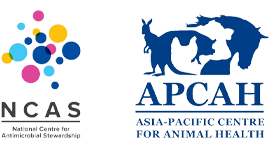AUSTRALIAN VETERINARY PRESCRIBING GUIDELINES
About us
The Australian Veterinary Prescribing Guidelines are evidence-based guidelines that have been created in a collaborative effort between the University of Melbourne’s Asia Pacific Centre for Animal Health (APCAH) and the National Centre for Antimicrobial Stewardship (NCAS). These guidelines are not static and we hope that you will also take an active role in this evolutionary process. Please suggest a disease or syndrome for guideline development where you think this would be of value. We’ve provided the published evidence for all our guidelines. If we’ve missed any key evidence in the development of a guideline, please submit a suggestion through this page.
Pharmacological information (still coming) on the common antimicrobials used in Australian veterinary practice. Check out all our resources using the tab above.
Importantly, these guidelines are independent, and we have no conflicts of interest to declare. All peer-reviewed research findings will be considered and critiqued, and guidelines adjusted as we see appropriate for the level of confidence we have in the research completed. Where evidence is lacking, this is stated and our recommendations are then based on human literature and expert opinion.
These have been created to serve as guidelines for the practitioner and the veterinary industry. As such, they do not have the force of law. All guidelines issued here should be regarded as one of several tools a practitioner may take into consideration in the context of their practice. Many of the recommendations in this guide represent off-label use of antimicrobials. All practitioners are encouraged first and foremost to understand and comply with the laws, regulations and standard of care of their appropriate jurisdiction. While guidelines are intended to promote a standard for veterinary practice, lack of adherence to any specific guideline does not constitute grounds for disciplinary action. The University of Melbourne and APCAH shall have no liability whatsoever for any guideline.

Contact information
Laura Hardefeldt laura.hardefeldt@unimelb.edu.au
Glenn Browning glenfb@unimelb.edu.au
Kirsten Bailey baileyk@unimelb.edu.au
You can also make a suggestion for additions, or modifications, to these guidelines:
